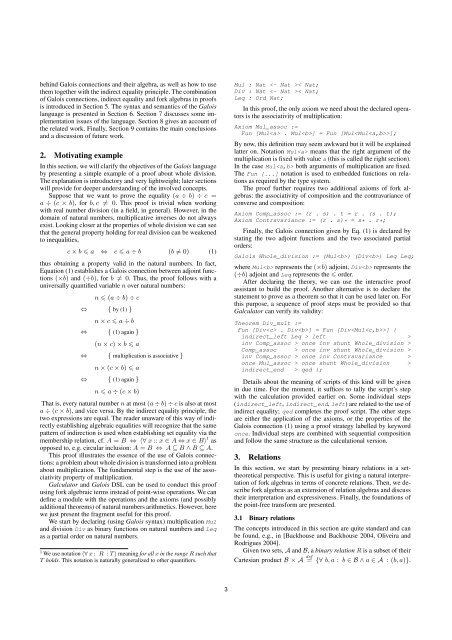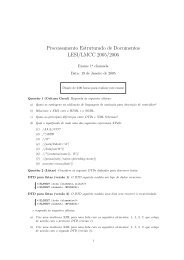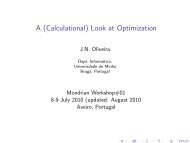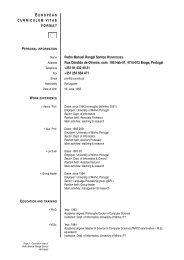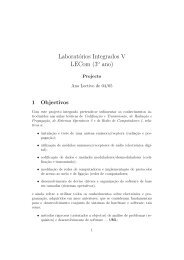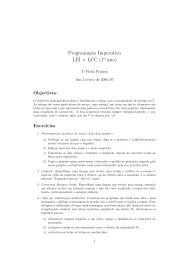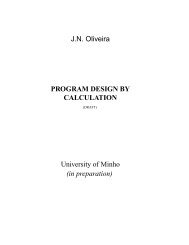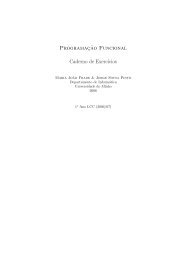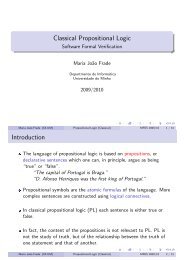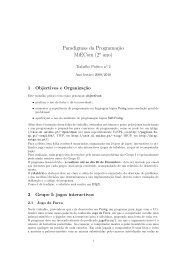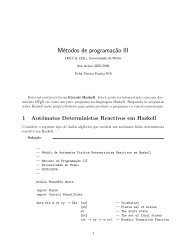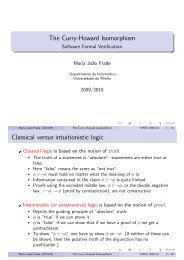Galois
Galois
Galois
Create successful ePaper yourself
Turn your PDF publications into a flip-book with our unique Google optimized e-Paper software.
ehind <strong>Galois</strong> connections and their algebra, as well as how to use<br />
them together with the indirect equality principle. The combination<br />
of <strong>Galois</strong> connections, indirect equality and fork algebras in proofs<br />
is introduced in Section 5. The syntax and semantics of the <strong>Galois</strong><br />
language is presented in Section 6. Section 7 discusses some implementation<br />
issues of the language. Section 8 gives an account of<br />
the related work. Finally, Section 9 contains the main conclusions<br />
and a discussion of future work.<br />
2. Motivating example<br />
In this section, we will clarify the objectives of the <strong>Galois</strong> language<br />
by presenting a simple example of a proof about whole division.<br />
The explanation is introductory and very lightweight; later sections<br />
will provide for deeper understanding of the involved concepts.<br />
Suppose that we want to prove the equality (a ÷ b) ÷ c =<br />
a ÷ (c × b), for b, c ≠ 0. This proof is trivial when working<br />
with real number division (in a field, in general). However, in the<br />
domain of natural numbers, multiplicative inverses do not always<br />
exist. Looking closer at the properties of whole division we can see<br />
that the general property holding for real division can be weakened<br />
to inequalities,<br />
c × b a ⇔ c a ÷ b (b ≠ 0) (1)<br />
thus obtaining a property valid in the natural numbers. In fact,<br />
Equation (1) establishes a <strong>Galois</strong> connection between adjoint functions<br />
(×b) and (÷b), for b ≠ 0. Thus, the proof follows with a<br />
universally quantified variable n over natural numbers:<br />
n (a ÷ b) ÷ c<br />
⇔ { by (1) }<br />
n × c a ÷ b<br />
⇔ { (1) again }<br />
(n × c) × b a<br />
⇔ { multiplication is associative }<br />
n × (c × b) a<br />
⇔ { (1) again }<br />
n a ÷ (c × b)<br />
That is, every natural number n at most (a ÷ b) ÷ c is also at most<br />
a ÷ (c × b), and vice versa. By the indirect equality principle, the<br />
two expressions are equal. The reader unaware of this way of indirectly<br />
establishing algebraic equalities will recognize that the same<br />
pattern of indirection is used when establishing set equality via the<br />
membership relation, cf. A = B ⇔ 〈∀ x :: x ∈ A ⇔ x ∈ B〉 1 as<br />
opposed to, e.g. circular inclusion: A = B ⇔ A ⊆ B ∧ B ⊆ A.<br />
This proof illustrates the essence of the use of <strong>Galois</strong> connections:<br />
a problem about whole division is transformed into a problem<br />
about multiplication. The fundamental step is the use of the associativity<br />
property of multiplication.<br />
Galculator and <strong>Galois</strong> DSL can be used to conduct this proof<br />
using fork algebraic terms instead of point-wise operations. We can<br />
define a module with the operations and the axioms (and possibly<br />
additional theorems) of natural numbers arithmetics. However, here<br />
we just present the fragment useful for this proof.<br />
We start by declaring (using <strong>Galois</strong> syntax) multiplication Mul<br />
and division Div as binary functions on natural numbers and Leq<br />
as a partial order on natural numbers.<br />
1 We use notation 〈∀ x : R : T 〉 meaning for all x in the range R such that<br />
T holds. This notation is naturally generalized to other quantifiers.<br />
Mul : Nat < Nat;<br />
Div : Nat < Nat;<br />
Leq : Ord Nat;<br />
In this proof, the only axiom we need about the declared operators<br />
is the associativity of multiplication:<br />
Axiom Mul_assoc :=<br />
Fun [Mul . Mul] = Fun [Mul];<br />
By now, this definition may seem awkward but it will be explained<br />
latter on. Notation Mul means that the right argument of the<br />
multiplication is fixed with value a (this is called the right section).<br />
In the case Mul both arguments of multiplication are fixed.<br />
The Fun [...] notation is used to embedded functions on relations<br />
as required by the type system.<br />
The proof further requires two additional axioms of fork algebras:<br />
the associativity of composition and the contravariance of<br />
converse and composition:<br />
Axiom Comp_assoc := (r . s) . t = r . (s . t);<br />
Axiom Contravariance := (r . s)* = s* . r*;<br />
Finally, the <strong>Galois</strong> connection given by Eq. (1) is declared by<br />
stating the two adjoint functions and the two associated partial<br />
orders:<br />
<strong>Galois</strong> Whole_division := (Mul) (Div) Leq Leq;<br />
where Mul represents the (×b) adjoint, Div represents the<br />
(÷b) adjoint and Leq represents the order.<br />
After declaring the theory, we can use the interactive proof<br />
assistant to build the proof. Another alternative is to declare the<br />
statement to prove as a theorem so that it can be used later on. For<br />
this purpose, a sequence of proof steps must be provided so that<br />
Galculator can verify its validity:<br />
Theorem Div_mult :=<br />
Fun [Div . Div] = Fun [Div] {<br />
indirect_left Leq > left ><br />
inv Comp_assoc > once inv shunt Whole_division ><br />
Comp_assoc > once inv shunt Whole_division ><br />
inv Comp_assoc > once inv Contravariance ><br />
once Mul_assoc > once shunt Whole_division ><br />
indirect_end > qed };<br />
Details about the meaning of scripts of this kind will be given<br />
in due time. For the moment, it suffices to tally the script’s step<br />
with the calculation provided earlier on. Some individual steps<br />
(indirect_left, indirect_end, left) are related to the use of<br />
indirect equality; qed completes the proof script. The other steps<br />
are either the application of the axioms, or the properties of the<br />
<strong>Galois</strong> connection (1) using a proof strategy labelled by keyword<br />
once. Individual steps are combined with sequential composition<br />
and follow the same structure as the calculational version.<br />
3. Relations<br />
In this section, we start by presenting binary relations in a settheoretical<br />
perspective. This is useful for giving a natural interpretation<br />
of fork algebras in terms of concrete relations. Then, we describe<br />
fork algebras as an extension of relation algebras and discuss<br />
their interpretation and expressiveness. Finally, the foundations of<br />
the point-free transform are presented.<br />
3.1 Binary relations<br />
The concepts introduced in this section are quite standard and can<br />
be found, e.g., in [Backhouse and Backhouse 2004, Oliveira and<br />
Rodrigues 2004].<br />
Given two sets, A and B, a binary relation R is a subset of their<br />
Cartesian product B × A def<br />
= {∀ b, a : b ∈ B ∧ a ∈ A : (b, a)}.<br />
3


